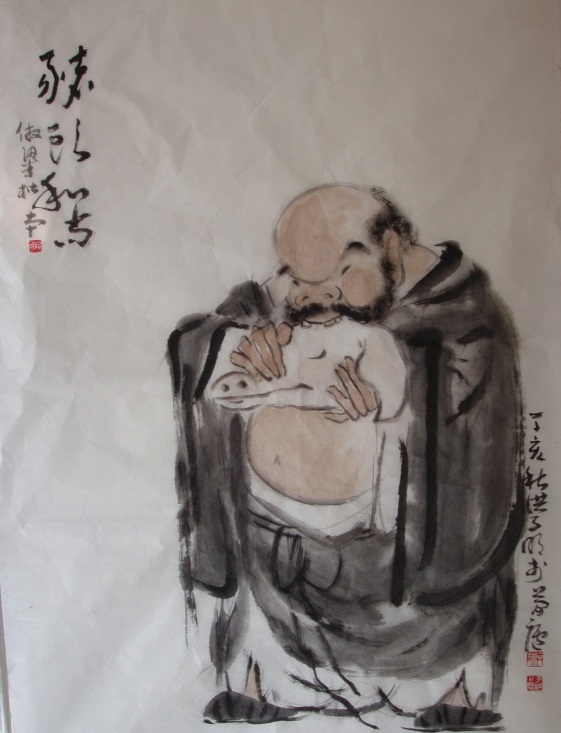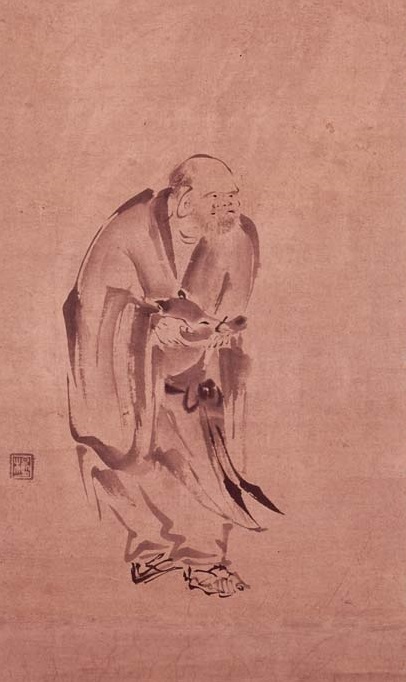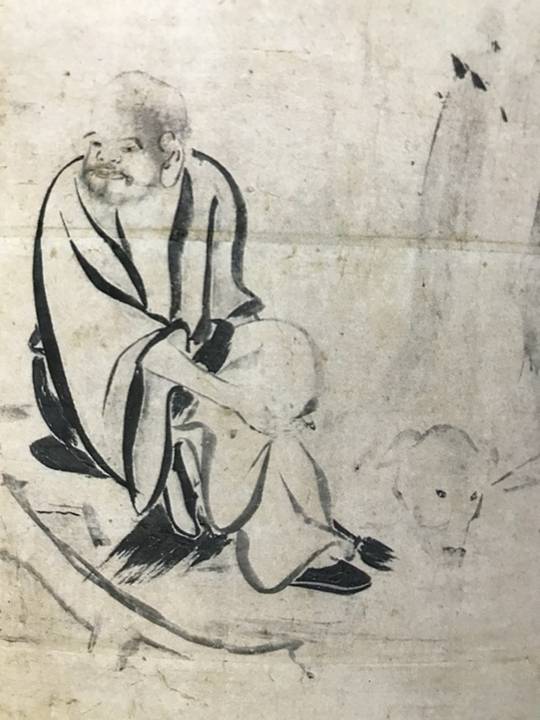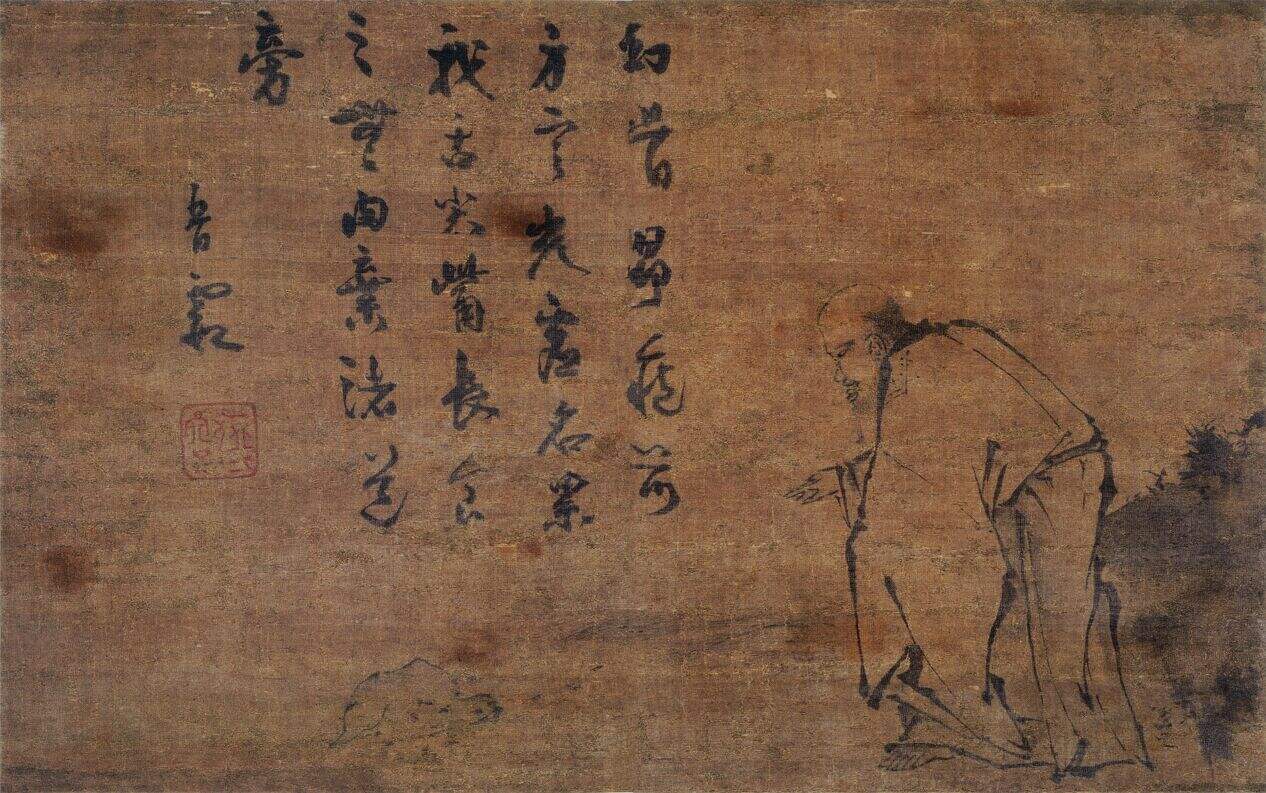ZEN MESTEREK ZEN MASTERS
« Zen főoldal
« vissza a Terebess Online nyitólapjára
志蒙 Zhimeng
猪頭和尚 Zhutou heshang
(Rōmaji:) Shimō, Chotō oshō
(English:) Pig's Head; Boar's Head Priest
(Magyar:) Disznófej-ínyes mester; Disznófő pap

Painting by 洪子明 Hong Ziming (1953-)
Chotou 猪頭
Ch: Zhutou. A painting subject depicting the Northern Song dynasty eccentric priest Zhimeng (Jp: Shimou 志蒙). He was known as Chotou Oshou 猪頭和尚 (Ch: Zhutou Heshang; Boar's Head Priest), because of his predilection for walking through town carrying the severed head of a boar which he was fond of eating. His family name was Xu 徐 and he lived in Wuzhou, present day Jinhua 金華. In painting he is usually depicted wearing ragged clothes and carrying the boar's head. By some reports Chotou was able to fly, and occasionally he is depicted in mid-air. The fact of his eating meat, flaunting the vegetarian Buddhist diet, has caused Chotou to be associated with the priest Kensu 硯子, who was fond of shellfish. The image of Chotou came to be worshipped for protection against drought and flood. Chinese paintings of the subject include works attributed to Liang Kai (Jp: Ryoukai 梁楷) and Muqi (Jp: Mokkei 牧谿). Japanese examples include paintings by the Kanou school Kanouha 狩野派 and a screen painting fusuma-e 襖絵, in Daitokuji Shinjuan 大徳寺真珠庵 by Hasegawa Touhaku 長谷川等伯 (1539-1610), Kyoto.
The identity of Chu-t'ou is rather unclear. His name means pig's head and he is usually shown eating a pig's head or holding one in his hands. He is usually said to represent a certain Chih Meng-hsu who was fond of eating pig and was therefore called "Pig's Head." There is nothing in Chih's biography, however, that could justify his inclusion in the Ch'an pantheon of eccentrics. There are two other Ch'an stories, which possibly could be relevant to this theme.
The first concerns the monk Wen-shu Ssu-yeh who started his career as a butcher. One day, on the point of killing yet another pig, he suddenly realized the error of his ways in a flash of revelation. He quit his trade to become a monk and composed the following gatha on the occasion:
Yesterday the heart of a [blood thirsty] Yaksa,
Today the face of a Bodhisattva.
Between the Bodhisattva and the Yaksa
There is not a shred of difference.When he went to Master Tao of Wen-shu, who was to become his teacher, the Master asked him: "What did you see when you were about to slaughter that pig? What made you shave your head and depart on a pilgrimage?" Ssu-yeh thereupon made a gesture as if he were whetting his knife.
Another possibility is that the representation of "Pig's Head" was inspired by an anecdote from the life of P'an-shan Pao-chi (720-814), a pupil of the great Patriarch Ma-tsu Tao-i (died 788).One day he saw a man in the marketplace enter a butcher's shop to buy meat. He heard him ask: "Please cut me a catty of the finest." The butcher dropped his knife, picked it up again and said: "My dear sir, what do we have here that is not of the finest?" Upon hearing these words Pao-chi suddenly attained Enlightenment.
-from Zen Painting and Calligraphy by J. Fontein and M.L. Hickman
牧溪法常 Muqi Fachang / Muxi Fachang (c.1210-1269); Japanese: 牧谿 Mokkei
猪头和尚
Pig's Head Monk
Seals: 退耕 (朱), 76 × 34 cm
楊月 Yōgetsu (fl. late 15th–early 16th century)
http://burkecollection.org/catalogue/98-chot%C5%8D-kensu
http://webarchives.tnm.jp/imgsearch/show/C0006937
猪頭
Chotō
28.5 x 22.8 cm
Minneapolis Institute of Arts, The Mary Griggs Burke Collection

猪頭
Chotō
90,9 × 33,3 cm
Tokyo National Museum
長谷川等伯 Hasegawa Tōhaku (1539-1610)
http://www.geocities.jp/themusasi5/a105.html
https://ameblo.jp/taishi6764/entry-12377178892.html

猪頭図
永真安信 Eishin Yasunobu (1613-1685)
出山釈迦(しゅうさんしゃか)・猪頭(ちょとう)和尚・蜆子(けんす)和尚図 3 幅 平成 2 年 4 月 6 日指定
|
筆者 狩野永真安信 無賛
|
妙喜宗績 Myōki Sōseki (1774-1848)

猪頭和尚の図
25 × 100 cm
瑞巌寺 Zuiganji Temple
猪頭図
